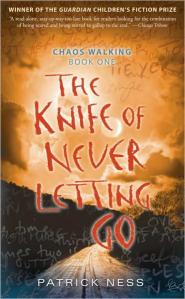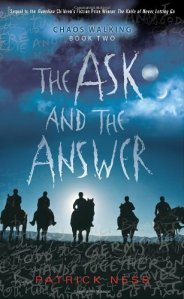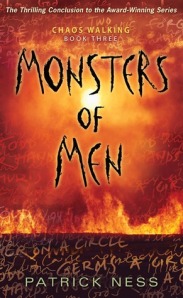 The task I have set for myself here is somewhat akin to walking a tightrope: for my next death-defying act, I will review an entire trilogy without massive spoilers (other than those which could be found by the reader on all three back covers)! Normally I would never attempt such a feat, but it is the only way to really do these books justice. I believe Ness’s series is truly one of the most insightful and important science fiction trilogies of the decade, and no, I do not mean “for young adult novels” (whatever that is intended to suggest). I mean period.
The task I have set for myself here is somewhat akin to walking a tightrope: for my next death-defying act, I will review an entire trilogy without massive spoilers (other than those which could be found by the reader on all three back covers)! Normally I would never attempt such a feat, but it is the only way to really do these books justice. I believe Ness’s series is truly one of the most insightful and important science fiction trilogies of the decade, and no, I do not mean “for young adult novels” (whatever that is intended to suggest). I mean period.
Thematically and plot-wise, Chaos Walking demands to be read as a trilogy: each new book simultaneously enhances and is informed by its predecessor(s), such that the full effect of the first book can only really be seen from the end of the third. A kind of literary nesting-doll, the series examines the nature of conflict on ever-larger scale: conflict between men, within a nation, and finally, all-out war between species. Individually and together the Chaos Walking books are illuminating, thought-provoking, gut-wrenching and impossibly addictive; fans of Phillip Pullman’s His Dark Materials trilogy take note: this is the series you have been waiting for.
Ness’s first book, The Knife of Never Letting Go, begins by following Todd Hewitt of New Prentisstown, a rural settlement located on the planet “New World,” which was settled by formerly-Earth-dwelling humans just over a decade before the story’s opening. The end of Earth is only ever alluded to throughout the series, but the implication is that our planet suffered from that most likely of apocalypses: humanity simply made it unlivable. Unending violent conflict and centuries of environmental degradation combined to destroy it, causing its inhabitants to look elsewhere for a place to start over.
New World, while environmentally similar to Earth, has two rather striking differences. The first is that the planet was inhabited by a native species called “Spackle” (supposedly wiped out by the early settlers). The second is that the Spackle’s final act was supposedly to inflict a “germ” on the settlers New World that causes the thoughts of every male creature – human and animal – to be heard at all times; supposedly, this same “germ” also killed all of New World’s women. Supposedly.
The complicated, horrific, and disturbingly plausible truth of New World unfolds slowly over the course of the three books, and is subject to a series of tellings and re-tellings until even the tellers are not quite sure just what is fact and what is fiction. This of course, is Ness’s point: not just that history is written by the victors in a deliberate exchange of lie for truth, but that at any given point the victors can change, and they even they may start to believe their own propaganda.
New Prentisstown is, from the get-go, a grim place, defined by illiteracy and backbreaking work, the deafening, depressing mental cacophony known as “Noise,” and the totalitarian power wielded by its leader Mayor Prentiss. But for Todd, the first boy born in the town, it’s home. Which is why he is shocked and terrified when, one night a few weeks before his thirteenth birthday (the day, according to New Prentisstown law, that a boy becomes a man), his foster fathers pack his bags, hand him a map, and tell him to run and never come back. Todd’s destination is Haven, a mysterious utopia that supposedly flourishes outside the reach of the Mayor’s iron fist.
Todd’s world is further shaken when he stumbles upon Viola, a girl and the sole survivor of a shipwreck of Earth ambassadors. Although her lack of Noise initially repels him, Todd and Viola cautiously become allies and eventually, friends – it is this slow-burning but deeply-felt friendship that will become the passionate heart of Ness’s trilogy.
Together, Todd and Viola battle injury, illness, a gruelling landscape and the brutal, insidious Mayor Prentiss on their journey. Of course, for the structure of his trilogy to work, Ness must make the meat of his series only begin with Haven; the settlement is nowhere near the oasis Todd and Viola so dearly hoped for, and not quite far enough away from The Mayor’s grasping hands.
 What follows in The Ask and The Answer is a deft exploration of the fine line between “terrorist” and “freedom fighter” (and for that matter, “terrorist” and “government”), and what happens when you find a loved one on the other side of that line. The backdrop of all this is an examination of wide-scale misogyny that is as frank in its criticism as it is startlingly believable in its origins. Future men of the world: read this, please.
What follows in The Ask and The Answer is a deft exploration of the fine line between “terrorist” and “freedom fighter” (and for that matter, “terrorist” and “government”), and what happens when you find a loved one on the other side of that line. The backdrop of all this is an examination of wide-scale misogyny that is as frank in its criticism as it is startlingly believable in its origins. Future men of the world: read this, please.
If misogyny is the issue that informs The Ask and The Answer, then racism and genocide are what sets the stage for Chaos Walking’s final chapter, Monsters of Men. Monsters of Men asks what it means to be a “person,” examines how easily that definition can be manipulated for truly horrific ends, and shows us what people – in this case, both of the human and Spackle variety – are capable of doing to those they consider to be not quite “one of us.”
While Ness’s plots are gripping and he is certainly to be commended for his deft handling of delicate or challenging themes – queer relationships and indigenous spirituality, as well as racism, terrorism and genocide – it is the characters that really make this series. Todd and Viola are so much more than your typical teenage protagonists: basically good-hearted and sympathetic yes, but also deeply and fundamentally flawed, mired in the kind of prickly, complicated failings that do not necessarily endear. In fact, time and time again, we see that our heroes are susceptible to the same motivations, weaknesses and blind spots as their foes. They make decisions based on personal interest rather than greater good; they feel anger and enact vengeance; they suffer wounds and struggle to forgive.
 Speaking of foes, the chilling Mayor Prentiss surely deserves a paragraph of his own. The Mayor is quite seriously one of the most terrifying and fascinating literary villains I have ever encountered, full stop. A brilliant, cruel and power-mad man, he is utterly heartless and yet unmistakably human, perpetually teetering on the edge of self-delusion. Todd’s relationship with the Mayor, poisonous but tinged with a dash of redemption, is like a car crash in slow motion – horrifying but impossible to look away from. Its complex toxicity provides a perfect foil to the complicated beauty of his relationship with Viola.
Speaking of foes, the chilling Mayor Prentiss surely deserves a paragraph of his own. The Mayor is quite seriously one of the most terrifying and fascinating literary villains I have ever encountered, full stop. A brilliant, cruel and power-mad man, he is utterly heartless and yet unmistakably human, perpetually teetering on the edge of self-delusion. Todd’s relationship with the Mayor, poisonous but tinged with a dash of redemption, is like a car crash in slow motion – horrifying but impossible to look away from. Its complex toxicity provides a perfect foil to the complicated beauty of his relationship with Viola.
If all this seems a bit heavy for a young adult novel (there’s that phrase again), let me assure you that it is. To say that Ness pulls no punches is woefully inadequate – Chaos Walking is relentless. Every loathsome, small and selfish impulse of mankind is on full display here, with the ugly, livid and stretched discomfort of raw skin. At times, it is difficult not to be beaten down by all this, and it is tempting to cast the books aside for something just a little less painful, a little less intense, a little less hard; but if, like Ness’s young heroes, you manage, through sheer stubbornness, defiance and the tiniest inextinguishable glimmer of hope, to persevere, you will be richly rewarded with a story that is just as much about the transformative power of compassion as it is about violence and hatred.
Not that that is a promise of happily ever after. There is no guarantee that the final result of all this fighting, suffering, and loss won’t be decades more of the same; but there is no guarantee that it will be. And that, in the end, is what Todd, Viola and a wide cast of compatriots are fighting for – not for an end, but for the ability to hope. Todd’s initial flight from New Prentisstown is motivated by hope, by the idea that if you look hard enough and go far enough, hope will be out there, just waiting for you. But it isn’t. Hope (and Haven) is not something you discover, it is something you fight for, something you pay for in ways you cannot anticipate and might never have chosen. Hope is not given or found, it is earned.
Ironically it is this perpetual striving, and the hope in spite of all the violence and instability, that makes Ness’s vision of the future not only the most realistic, but the one most worth fighting for. In this future world, humanity has destroyed its own planet, and gone about the business of trying to destroy another one. It has dehumanized a fellow sentient species. It has victimized its own. It has wrought destruction with the choices individual people have made, even if that choice is simply to stand back.
And yet. And yet that isn’t the full story. And yet there are people who fight, people who sacrifice, people who love and forgive, people who stand up instead of back. When the people who destroy are finished, these are the people who build again. It is not easy, but there is value in the building. And each time we build ourselves up again there is hope.